
Hail to the kings, baby.
In last week’s post I identified the essential attributes of a role-playing game, which include the ability to influence the player-directed narrative by customizing various character skills, statistics, and gender. The notion that you’re playing as a wholly unique, individual character, with that character’s ongoing progression driven solely by your choices, is an indispensable element of any role-playing experience, whether it takes place on a tabletop, a desktop, or a LARP field; all character customization must occur first in the player’s mind before it can be transferred to an avatar, either of the digital or physical variety.
As a result of all this player-directed whatsis, role-playing games are necessarily paced more slowly than their action-oriented brethren, as whatever occurs in the game itself is properly an expression of player choice and action, not the cause of it. Sure, there’s the ridiculously labelled “action-rpg,” a moniker that’s meant to indicate that enemy encounters occur in real time instead of the more traditional turn-based model, but in general role-playing games relegate action to a slightly lower league than elements like story and character progression. And that’s just fine. Most of the time.
Sometimes you just want to kick a little ass, or frankly a lot of ass, and for that you need a shooter, preferably of the first-person variety. Compiled herein are the five best pure first-person shooters I’ve ever played, with but a few informative caveats: by “pure” I mean that these games are not primarily concerned with telling stories or developing deep and engaging characters; although some of them do tell passable stories, their collective raison d’etre is action, with an emphasis on shooting the living baboon shit out of lots of bad guys — as such, games like Deus Ex and System Shock 2 (two of my all-time favorites), in which action is secondary to character development and story, are not eligible.
In order to qualify for consideration, a game must possess the following attributes: first; shooting isn’t optional. If there’s a gun in your hand in the first act, you’ll be using it to debrainify some uglies shortly and perpetually thereafter. Second; action must take precedence over anything else, including story, even if only by a slim margin. Third; it must not have any role-playing or character customization mechanics. Fourth; it must be unique in some way as to be determined and indicated by me.
Behold, in no particular order:
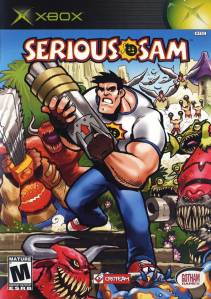
Works on the Xbox 360. Find a copy. Play it. Thank me later.
Serious Sam (Xbox) — The PC version of Serious Sam was released in March of 2001 as Serious Sam: The First Encounter. It cost a paltry $20, ran like hot butter on Patrick Stewart’s pate in mid-July, and was all manner of alien-blasting, ridiculous fun. It would have been included on this list if not for the modified Xbox port that was released in September of 2002, which offered a number of improvements over its predecessor.
The original Serious Sam kept score as you played, displaying your prowess in base-ten numerical form at the top-center of the screen. At the end of each level the game tallied your score even further, adding to it by calculating a number of predetermined categories, including time to completion, enemies killed, secrets found, and treasures collected. While it was fun to watch the numbers roll in, the score was meaningless; it had no bearing at all on the gameplay, which turned it into a floating, isolated pseudo-mechanic, unconnected to anything that you could do in the game.
Serious Sam on the Xbox changed that. While the original sported a save-anywhere option (F6 FTW), which I always appreciate, the Xbox version integrated the score with a respawn feature that awarded an extra life for every 100,000 points. Your life total was displayed on-screen, so that it became a compelling collection mechanic in its own right, which would decrease upon player death — the punishment for in-game ineptitude was watching your store of lives diminish, as opposed to being forced to replay sections of the game that you’d already completed (unless, of course, your number of lives dropped to zero, in which case you’d start at the the previous save point). Add this to the fact that the game was good, wholesome, explodey fun, with additions like hippie blood, combo multipliers, and the inclusion of Serious Sam: The Second Encounter, and you’ve got a shooter that has yet to be matched on any platform for its amount of sheer, bullet-ripping entertainment.
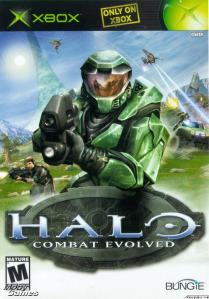
Still my favorite launch title ever. Seriously. Ever.
Halo (Xbox) — How many people walked away with a new Xbox in 2001 (or even 2002) without a copy of Halo? I’m almost ashamed to admit it, but I did — the game that I bought with my Xbox in June of 2002 was The Elder Scrolls III: Morrowind, but Halo was a close runner-up.
Halo was the first console game to ford the trench between the sophistication of PC games and the accessibility of console games. It was PC-like in its presentation, with specular mapping and fairly detailed textures for its time, while offering unmatched shooting mechanics on a console and telling a compelling story without the need to cram cutscene after intrusive cutscene down your throat at every opportunity. Halo was the first game that I played on any platform that effectively evoked a feeling of isolation and despair with its storytelling and setting; the knowledge that you were your own and others’ best hope for survival, coupled with the crushing sense of failure that accompanied the death of friendly NPCs, helped craft an experience that was unparalleled for its emotional subtlety. Unlike most games of the early sixth console generation, Halo remains fresh and playable even today, 12 years later.
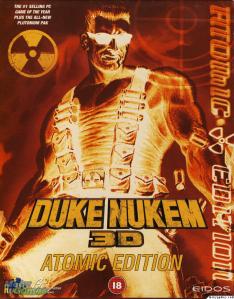
The Atomic Edition box was its own bling.
Duke Nukem 3D (PC) — Duke Nukem 3D is to video games what Chuck Norris is to…well, everything; it was the first first-person shooter to satirize the violence that was the primary staple of other “serious” FPS titles of the day, but it did so by integrating a parodical main character with an over-the-top premise and rolling the whole thing into a ball of ass-kicking, name-taking, bubble-gum-chewing (or not), face-melting, hyphenated-adjective-phrase deliciousness. Anyone who can be offended by the manners, actions, or personality of a video game character like Duke Nukem should consider inserting himself into his own rectum and ceasing to function as an autonomous organic organism, but not before going back to school to learn the meaning of the words “fucking satire.”
Part of the appeal of Duke Nukem 3D back in 1996 was hearing that next raunchy line of dialogue, not because it indicated how men actually thought at the time (well, not all of us, anyway), but because it was like the developers were sitting at your elbow while you played, pointing out things like misogyny, xenophobia (and by extension, racism), and celebrity worship, and laughing at them, thereby rendering them if not impotent, then slightly less aggressively tumescent than they might have been otherwise. Since we’ve spent the last 17 years in a leg-locked chokehold of rampant, knee-jerk social conditioning, in which any perceived slight is used to create ever-broadening circles of victims to populate various special-interest groups (with or without said victims’ knowledge or approval), thus increasing their political and social capital, it’s no wonder that Duke Nukem Forever was universally despised.
Duke Nukem 3D has enjoyed a recent revival in the Megaton Edition (available on Steam), which sports updated graphics and controls, but preserves the game’s classic action and relentless parody of the absurd.
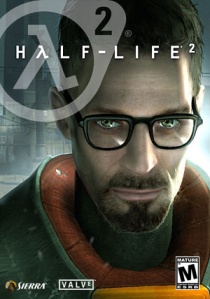
After defeating the Combine, Gordon Freeman moved to Albuquerque, started a “business,” and adopted an alias. Say his name.
Half-Life 2 (PC) — At the time of its release, Half-Life 2 was the best-looking game I’d ever played, and it hasn’t lost much of its visual chutzpah in the intervening nine years; it’s still a good-looking game, but its primary strength lies in its compelling, headlong presentation and its visceral, “almost palpable” combat. I still remember the first time I fired one of its weapons, a simple action which I’d accomplished thousands of times in hundreds of other games, yet which persists in my memory because of the Source engine’s impressive physics; the hapless metrocop that I shot in the head went down like a bag of hams at Rosie O’Donnell’s house, and I was instantly hooked. Like I said; visceral.
More impressive than that is the fact that the game never holds your hand, never interrupts your progression with meaningless creature intros (Hi, Doom 3! Still bitter!), and never breaks the immersion by forcing you to watch instead of letting you play. It was also the first big commercial release on Steam, ushering in — albeit slowly — a new model of distribution for PC games, one which other companies like Microsoft and Sony are only beginning to embrace. It wasn’t until recently that newly released games became available for download on Xbox Live and Sony Entertainment Network (PSN to you and me), which is something that Valve has been doing with Steam since 2004. Thanks, Half-Life 2.
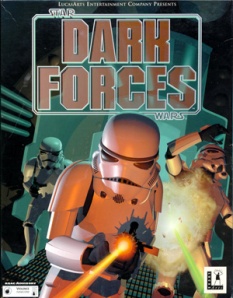
There’s one. Set for fun!
Dark Forces (PC) — Here you have Star Wars incorporated into a first-person shooter. That’s really all I should have to write, because it’s Star Wars incorporated into a first-person shooter! When it came out in February of 1995, I’d gone 18 years without shooting a stormtrooper in the face, and this game made that previously unrealized dream a ubiquitous virtual reality; if you like shooting stormtroopers in the face — or in any other part of their varied plasticity — you’ll glean satisfaction in effluence with Dark Forces. There’s also a good number of Imperial officers, Imperial commandos, Trandoshans, Grans, probe droids, interrogation droids, remotes, dianogas, Gamorrean guards, Kell dragons, and several game-specific enemies, all of which you may dispatch at your leisure and/or righteous geek gratification.
I couldn’t even begin to estimate the number of hours I spent with Dark Forces in 1995 and 1996, but for months it consumed every free moment that I had. It was a pain in the ass to set up; it required a DOS boot disk in order for the sound to work on a 90 MHz Pentium with the earliest version of Windows 95, but it was worth the trouble of rebooting into DOS every time I wanted to play. (After all, it was Star Wars incorporated into a first-person shooter!) To this day it remains the second-best Star Wars game I’ve played, right behind its sequel, Jedi Knight: Dark Forces II (and it was also one of the best Christmas gifts I’ve ever received). It doesn’t hold up as well today as Jedi Knight does, but the fact that it was the first game to place you inside the Star Wars universe as a first-person participant earns it a permanent spot in my pantheon of all-time favorite games. That it also happens to be one of the best first-person shooters that I’ve played is just icing on the tauntaun’s muzzle.
It’s a testament to the quality of the aforementioned games that this post turned out so much longer than I’d intended. There were three honorable mentions that I had to omit for their role-playing tendencies, namely BioShock, BioShock Infinite, and Dark Forces II: Jedi Knight, but that’s not intended as a slight; on an ordered, broader list they’d all be near the top. As it stands, and if only by association, they’re still in some pretty lofty company.

Shooting Star
Hail to the kings, baby.
In last week’s post I identified the essential attributes of a role-playing game, which include the ability to influence the player-directed narrative by customizing various character skills, statistics, and gender. The notion that you’re playing as a wholly unique, individual character, with that character’s ongoing progression driven solely by your choices, is an indispensable element of any role-playing experience, whether it takes place on a tabletop, a desktop, or a LARP field; all character customization must occur first in the player’s mind before it can be transferred to an avatar, either of the digital or physical variety.
As a result of all this player-directed whatsis, role-playing games are necessarily paced more slowly than their action-oriented brethren, as whatever occurs in the game itself is properly an expression of player choice and action, not the cause of it. Sure, there’s the ridiculously labelled “action-rpg,” a moniker that’s meant to indicate that enemy encounters occur in real time instead of the more traditional turn-based model, but in general role-playing games relegate action to a slightly lower league than elements like story and character progression. And that’s just fine. Most of the time.
Sometimes you just want to kick a little ass, or frankly a lot of ass, and for that you need a shooter, preferably of the first-person variety. Compiled herein are the five best pure first-person shooters I’ve ever played, with but a few informative caveats: by “pure” I mean that these games are not primarily concerned with telling stories or developing deep and engaging characters; although some of them do tell passable stories, their collective raison d’etre is action, with an emphasis on shooting the living baboon shit out of lots of bad guys — as such, games like Deus Ex and System Shock 2 (two of my all-time favorites), in which action is secondary to character development and story, are not eligible.
In order to qualify for consideration, a game must possess the following attributes: first; shooting isn’t optional. If there’s a gun in your hand in the first act, you’ll be using it to debrainify some uglies shortly and perpetually thereafter. Second; action must take precedence over anything else, including story, even if only by a slim margin. Third; it must not have any role-playing or character customization mechanics. Fourth; it must be unique in some way as to be determined and indicated by me.
Behold, in no particular order:
Works on the Xbox 360. Find a copy. Play it. Thank me later.
Serious Sam (Xbox) — The PC version of Serious Sam was released in March of 2001 as Serious Sam: The First Encounter. It cost a paltry $20, ran like hot butter on Patrick Stewart’s pate in mid-July, and was all manner of alien-blasting, ridiculous fun. It would have been included on this list if not for the modified Xbox port that was released in September of 2002, which offered a number of improvements over its predecessor.
The original Serious Sam kept score as you played, displaying your prowess in base-ten numerical form at the top-center of the screen. At the end of each level the game tallied your score even further, adding to it by calculating a number of predetermined categories, including time to completion, enemies killed, secrets found, and treasures collected. While it was fun to watch the numbers roll in, the score was meaningless; it had no bearing at all on the gameplay, which turned it into a floating, isolated pseudo-mechanic, unconnected to anything that you could do in the game.
Serious Sam on the Xbox changed that. While the original sported a save-anywhere option (F6 FTW), which I always appreciate, the Xbox version integrated the score with a respawn feature that awarded an extra life for every 100,000 points. Your life total was displayed on-screen, so that it became a compelling collection mechanic in its own right, which would decrease upon player death — the punishment for in-game ineptitude was watching your store of lives diminish, as opposed to being forced to replay sections of the game that you’d already completed (unless, of course, your number of lives dropped to zero, in which case you’d start at the the previous save point). Add this to the fact that the game was good, wholesome, explodey fun, with additions like hippie blood, combo multipliers, and the inclusion of Serious Sam: The Second Encounter, and you’ve got a shooter that has yet to be matched on any platform for its amount of sheer, bullet-ripping entertainment.
Still my favorite launch title ever. Seriously. Ever.
Halo (Xbox) — How many people walked away with a new Xbox in 2001 (or even 2002) without a copy of Halo? I’m almost ashamed to admit it, but I did — the game that I bought with my Xbox in June of 2002 was The Elder Scrolls III: Morrowind, but Halo was a close runner-up.
Halo was the first console game to ford the trench between the sophistication of PC games and the accessibility of console games. It was PC-like in its presentation, with specular mapping and fairly detailed textures for its time, while offering unmatched shooting mechanics on a console and telling a compelling story without the need to cram cutscene after intrusive cutscene down your throat at every opportunity. Halo was the first game that I played on any platform that effectively evoked a feeling of isolation and despair with its storytelling and setting; the knowledge that you were your own and others’ best hope for survival, coupled with the crushing sense of failure that accompanied the death of friendly NPCs, helped craft an experience that was unparalleled for its emotional subtlety. Unlike most games of the early sixth console generation, Halo remains fresh and playable even today, 12 years later.
The Atomic Edition box was its own bling.
Duke Nukem 3D (PC) — Duke Nukem 3D is to video games what Chuck Norris is to…well, everything; it was the first first-person shooter to satirize the violence that was the primary staple of other “serious” FPS titles of the day, but it did so by integrating a parodical main character with an over-the-top premise and rolling the whole thing into a ball of ass-kicking, name-taking, bubble-gum-chewing (or not), face-melting, hyphenated-adjective-phrase deliciousness. Anyone who can be offended by the manners, actions, or personality of a video game character like Duke Nukem should consider inserting himself into his own rectum and ceasing to function as an autonomous organic organism, but not before going back to school to learn the meaning of the words “fucking satire.”
Part of the appeal of Duke Nukem 3D back in 1996 was hearing that next raunchy line of dialogue, not because it indicated how men actually thought at the time (well, not all of us, anyway), but because it was like the developers were sitting at your elbow while you played, pointing out things like misogyny, xenophobia (and by extension, racism), and celebrity worship, and laughing at them, thereby rendering them if not impotent, then slightly less aggressively tumescent than they might have been otherwise. Since we’ve spent the last 17 years in a leg-locked chokehold of rampant, knee-jerk social conditioning, in which any perceived slight is used to create ever-broadening circles of victims to populate various special-interest groups (with or without said victims’ knowledge or approval), thus increasing their political and social capital, it’s no wonder that Duke Nukem Forever was universally despised.
Duke Nukem 3D has enjoyed a recent revival in the Megaton Edition (available on Steam), which sports updated graphics and controls, but preserves the game’s classic action and relentless parody of the absurd.
After defeating the Combine, Gordon Freeman moved to Albuquerque, started a “business,” and adopted an alias. Say his name.
Half-Life 2 (PC) — At the time of its release, Half-Life 2 was the best-looking game I’d ever played, and it hasn’t lost much of its visual chutzpah in the intervening nine years; it’s still a good-looking game, but its primary strength lies in its compelling, headlong presentation and its visceral, “almost palpable” combat. I still remember the first time I fired one of its weapons, a simple action which I’d accomplished thousands of times in hundreds of other games, yet which persists in my memory because of the Source engine’s impressive physics; the hapless metrocop that I shot in the head went down like a bag of hams at Rosie O’Donnell’s house, and I was instantly hooked. Like I said; visceral.
More impressive than that is the fact that the game never holds your hand, never interrupts your progression with meaningless creature intros (Hi, Doom 3! Still bitter!), and never breaks the immersion by forcing you to watch instead of letting you play. It was also the first big commercial release on Steam, ushering in — albeit slowly — a new model of distribution for PC games, one which other companies like Microsoft and Sony are only beginning to embrace. It wasn’t until recently that newly released games became available for download on Xbox Live and Sony Entertainment Network (PSN to you and me), which is something that Valve has been doing with Steam since 2004. Thanks, Half-Life 2.
There’s one. Set for fun!
Dark Forces (PC) — Here you have Star Wars incorporated into a first-person shooter. That’s really all I should have to write, because it’s Star Wars incorporated into a first-person shooter! When it came out in February of 1995, I’d gone 18 years without shooting a stormtrooper in the face, and this game made that previously unrealized dream a ubiquitous virtual reality; if you like shooting stormtroopers in the face — or in any other part of their varied plasticity — you’ll glean satisfaction in effluence with Dark Forces. There’s also a good number of Imperial officers, Imperial commandos, Trandoshans, Grans, probe droids, interrogation droids, remotes, dianogas, Gamorrean guards, Kell dragons, and several game-specific enemies, all of which you may dispatch at your leisure and/or righteous geek gratification.
I couldn’t even begin to estimate the number of hours I spent with Dark Forces in 1995 and 1996, but for months it consumed every free moment that I had. It was a pain in the ass to set up; it required a DOS boot disk in order for the sound to work on a 90 MHz Pentium with the earliest version of Windows 95, but it was worth the trouble of rebooting into DOS every time I wanted to play. (After all, it was Star Wars incorporated into a first-person shooter!) To this day it remains the second-best Star Wars game I’ve played, right behind its sequel, Jedi Knight: Dark Forces II (and it was also one of the best Christmas gifts I’ve ever received). It doesn’t hold up as well today as Jedi Knight does, but the fact that it was the first game to place you inside the Star Wars universe as a first-person participant earns it a permanent spot in my pantheon of all-time favorite games. That it also happens to be one of the best first-person shooters that I’ve played is just icing on the tauntaun’s muzzle.
It’s a testament to the quality of the aforementioned games that this post turned out so much longer than I’d intended. There were three honorable mentions that I had to omit for their role-playing tendencies, namely BioShock, BioShock Infinite, and Dark Forces II: Jedi Knight, but that’s not intended as a slight; on an ordered, broader list they’d all be near the top. As it stands, and if only by association, they’re still in some pretty lofty company.
Leave a comment
Filed under Commentary
Tagged as Bad Company, Dark Forces, Duke Nukem, Gordon Freeman, Halo, Serious Sam